Living in a lighthouse
Around the Great Lakes, volunteers keep the light on for tourists.
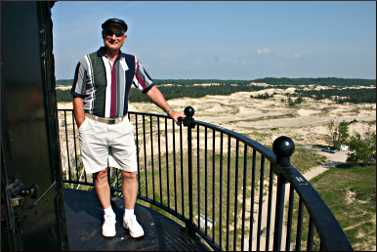
© Beth Gauper
Around the Great Lakes, love for lighthouses is unlimited. Often called "America's castles," lighthouses are symbols of a more adventurous era, and tourists find them irresistible.
Now, the state parks and friends associations who care for them have found a way to harness all this passion: They're turning tourists into volunteer keepers.
For a week or two, volunteers live at the lighthouse, hosting visitors and doing chores. Some get to sleep under quilts in the historic keepers' quarters.
Some stay at nearby cabins, and others, like Molly and Rich Hoeg of Duluth, choose to camp at the remote 1904 Crisp Point Light near Michigan's Shipwreck Coast.
"We liked having it to ourselves," said Molly Hoeg. "There wasn't anyone allowed to stay over but us."
Volunteer slots are available at many lighthouses around Lake Superior and Michigan.
At Crisp Point on the Upper Peninsula, the Hoegs hosted only 12 to 20 visitors a day, so Rich had plenty of time to shoot photos for his blog and Molly for her blog.
Some visitors were looking for agates, some came to photograph the lighthouse and many were avid fans who wanted their lighthouse passports stamped.
"You got people who have been to hundreds of lighthouses and are on their fourth passports," Molly Hoeg said.
The couple's first stint was in June, a good time for agate-hunting but not for escaping black flies. The next year, they went back in September.
At Crisp Point, volunteers have to navigate 18 miles of bumpy road, and there's no drinking water or electricity at the site.
But in Lower Michigan, at 1869 Tawas Point Light on Lake Huron, volunteers live in newly restored keeper's quarters amid period furnishings, some of them original.
This lighthouse, on a sandy spit often called "the Cape Cod of the Midwest," is much busier.
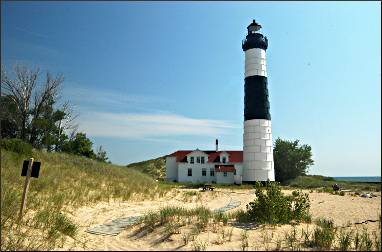
© Torsten Muller
Volunteers work five days a week, interpreting the history for visitors, helping in the gift shop and performing light maintenance.
For this, they pay $75 apiece for their two-week working vacation.
Tawas Point State Park modeled its volunteer-keeper program on the one in Leelanau State Park on Michigan's west coast, home of Grand Traverse Light.
That program was modeled on the one developed by the Sable Points Lighthouse Keepers Association, a friends society that cares for Big Sable and Little Sable Point and the Ludington North Breakwater Light in Ludington, Mich.
Volunteers at those lights don't pay, though.
"If people are paying $220, they might think they're on vacation, and they are, but it's a working vacation," says association director Craig Renny.
When we visited the 1867 Big Sable Point lighthouse in Ludington State Park, on the sandy shores of Lake Michigan, we met Larry Gorsh and Sandy Silver of Sibley, Mo., who were sharing lighthouse-keeping duties for two weeks with three other couples from three other states.
Larry was stationed at the top of the 112-foot tower, which visitors can climb. We chatted about the oddity of a lighthouse on a lake — "I've caught myself saying to visitors, 'Look out at the ocean,' " he admitted — and the long hours.
The first week, the couple got half a day off and visited nearby Sleeping Bear Dunes National Lakeshore. The second week, they got a whole day off and went to Mackinac Island. Gorsh said he loves the job.
"Where Sandy and I work, we say, 'We're going to work at a lighthouse for two weeks,' and people say, 'You're going to work on vacation?' And I say, 'You don't understand.'
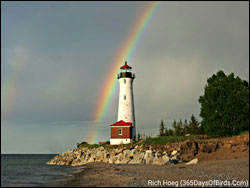
© Rich Hoeg
"Last week, we had people from Germany, Switzerland and Norway; it's incredible," he says.
I asked what lighthouse he wanted to volunteer at next.
"We've decided we want to come back here, with the same four couples," he said. "The camaraderie grows pretty quickly out here."
Volunteer keepers also staff the DeTour Reef Light, in open water east of the Mackinac Bridge, and the Pottawatomie Light in Rock Island State Park, off the tip of Wisconsin's Door Peninsula.
In the Apostle Islands off Wisconsin's Bayfield Peninsula, the National Park Service appoints volunteers to staff the lighthouses at Sand, Devils and Michigan islands during the summer tourist season.
The parks look for people who can spend a week or more working, and the application process is rigorous, generally requiring a letter of intent, a resume, two letters of recommendation, a phone interview and orientation.
Some people love lighthouses so much they want to live there permanently. In 2007, a couple was chosen from 159 applicants to permanently staff the Wind Point Lighthouse in Racine, Wis., and host the popular summer tower climbs.
Below are some of the volunteer-keeper opportunities on the western Great Lakes. There are also many positions in national parks.
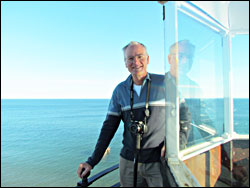
© Molly Hoeg
Upper Peninsula of Michigan
Crisp Point Light north of Newberry: At this remote lighthouse on Lake Superior, volunteer keepers can sign up as early as Nov. 1. There's no indoor housing, so keepers use tents or RVs and must bring their own water.
Groups of at least two and up to four adult keepers are needed for stints of up to five days, and they must be members of the Crisp Point Light Historical Society, $30 for a family.
The light is 14 miles west of Whitefish Point and the Great Lakes Lighthouse Museum, but not accessible by car from it. It's 36 miles from Newberry and Paradise.
Au Sable Light in Pictured Rocks National Lakeshore: The National Park Service appoints volunteer keepers to spend up to a month in a one-bedroom apartment on the second floor of the 1910 head-keepers quarters at this 1874 light on the edge of Lake Superior, 12 miles west of Grand Marais on Michigan's Upper Peninsula.
Keepers do light maintenance and help with the new museum and gift shop. After Jan. 1, apply with the National Park Service.
For more, see Dunes of Grand Marais and Michigan's Pictured Rocks.
DeTour Reef Light off Drummond Island: This 1931 offshore light at the mouth of the St. Marys River, between Lake Huron and Lake Superior, needs four to six volunteer keepers on Fridays through Sundays from mid-June through Labor Day. Access is via a 20-foot vertical ladder.
Cost for a three-day, two-night shift is $245, $225 with a $30 family membership. Minors are allowed here, accompanied by a legal guardian, and get a 50 percent discount.
St. Helena Island Light Station west of the Mackinac Bridge: This 1873 abandoned light, two miles offshore, is owned by the Great Lakes Lighthouse Keepers Association.
Keepers do upkeep, but do not have to deal with tourists. Sunday to Thursday stays are $320 and Thursday to Sunday stays are $240, including housing, meals and transportation. Singles, couples and families with children at least 8 years old are welcome.
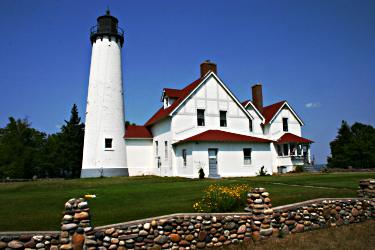
© Beth Gauper
Cheboygan River Front Range Light: Just east of Mackinaw City and across from Mackinac Island, this 1880 lighthouse in downtown Cheboygan is owned by the Great Lakes Lighthouse Keepers Association.
Volunteers live in the three-bedroom lighthouse and give tours, run the gift shop and do upkeep Thursdays-Sundays in summer and Saturdays-Sundays until the first week of October. Fee for the five-night stay is $125 per person and $50 for each addition person up to four, and the three-night stay is $75 and $25 for each additional person.
White Shoal Lighthouse west of the Mackinac Straits: This candy-striped light, the tallest in the Great Lakes, stands in open water 22 miles west of the Mackinac Bridge.
The White Shoal Light Historical Preservation Society offers weeklong volunteer opportunities from May to mid-September. The fee is $250, plus a share of food costs. From mid-August to mid-September, it offers three-night overnight adventure packages for five people in three bedrooms, $3,000 for a queen room and $1,500 for a twin room, including the boat trip.
Point Iroquois Lighthouse near Brimley: This 1871 lighthouse in Hiawatha National Forest, 33 miles west of Sault Ste. Marie, seeks a keeper to serve for at least a year.
The site receives many visitors, and keepers have a heavy workload. Couples are encouraged to apply. Lodgings are in the west wing of the lighthouse.
Lower Michigan
Tawas Point Light near Tawas City: Volunteer keepers pay $75 per person for a two-week stint in the lighthouse and are expected to work 35 hours a week, from Thursday through Monday. The program runs from May through early October.
The lighthouse is on Lake Huron in Tawas Point State Park. Applications are taken through early February, and those accepted are asked to attend a training session in April.
Big Sable Point, Little Sable Point and North Breakwater Light around Ludington: The Sable Points Lighthouse Keepers Association accepts volunteers keepers for one- or two-week stints. Keepers in Ludington and Little Sable stay at nearby houses once used by state-park managers.
Applicants must apply in fall, appear for a personal interview in Ludington in late October and, if they're accepted, attend an all-day orientation in late April.
Keepers don't pay for lodgings, but there's an application fee of $30, $50 for couples, and they must be members of the association, $60, $100 for couples.
Five to seven keepers can work at the 1867 Big Sable, four to five at the 1874 Little Sable and four at the small 1924 Ludington light, which is at the end of a long pierhead in town.
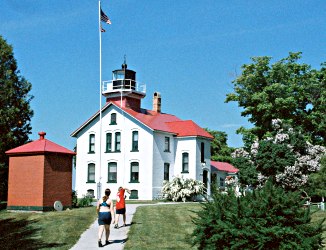
© Beth Gauper
Grand Traverse Light on the Leelanau Peninsula: Four volunteer keepers pay $200 per week, including a $50 nonrefundable application fee.
Volunteers stay in the former assistant's quarters, which has a modern kitchen, a living room, two bedrooms with two beds each and a bath and a half.
The season runs from April through early December.
In winter, keepers pay $100 for up to four people, plus museum membership. There's a three-night minimum.
South Fox Island Lighthouse off the Leelanau Peninsula: The 1867 lighthouse on this island 30 miles off the mainland has been abandoned, and keepers work on upkeep and restoration projects and as docents for visitors.
Keepers are asked to work for at least two weeks can either camp or sleep in bunk beds in one of several buildings.
Old Mission Point Light on Old Mission Peninsula: Grand Traverse takes applications for volunteer keeper stays at this 1870 schoolhouse-style light, on a narrow finger of land north of Traverse City.
Cost is $200 for one week, $370 for two, with Mondays off, and everyone must apply with a partner. From December through April, volunteers can work weekends for $75, including single keepers.
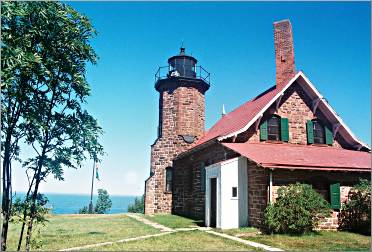
© Beth Gauper
Wisconsin
Sand, Devils and Michigan lights in the Apostle Islands National Lakeshore: The park starts filling volunteer keeper positions in January, ideally for three- or four-week stretches, but positions may be available through spring. There's a lot of work, so couples are preferred.
Keepers on Sand Island stay in a modern cabin but must walk two miles to the lighthouse and have the most campground work. On Devils Island, they have running water but a lot of grass to cut.
Michigan, which has two lighthouses, has the most steps to climb, but the campground isn't busy and, says ranger Susan Mackreth, "it has some of the coolest stories to tell."
Positions also are available on Oak and Manitou islands. People who are interested should call 715-779-3397, Ext. 303, to discuss opportunities.
"People hear 'lighthouses' and they have this whole romantic notion, so it takes a lot of chipping away to get down to reality," she says.
For details, see Lighthouses of the Apostles.
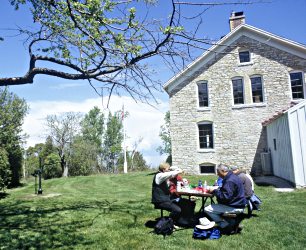
© Beth Gauper
Baileys Harbor Range Lights in Baileys Harbor: Ridges Sanctuary, which includes the two 1869 lights, offers free weeklong stays from June through October for resident docents, who lead tours and manage operations for the lights near the tip of Door County.
Applications become available Dec. 31 and are due by Jan. 31. Accommodations are in the Upper Range Light.
Pottawatomie Light on Rock Island State Park: The Friends of Rock Island State Park recruit volunteer docents to spend a week at this 1858 lighthouse at the farthest tip of Door County.
It's open daily from Memorial Day to Columbus Day. Applications can be submitted at any time but are reviewed in early March for the next season.
For more on Rock Island, see Wisconsin's Icelandic outpost.
Ontario
Porphyry Island Light east of Thunder Bay: From late June to late August, host keepers stay for a week at this lighthouse, reached by charter boat from Silver Inlet in Sleeping Giant Provincial Park.
Keepers work on various projects. Cost is $105 for boat transport and $210 for a private bedroom.
Couples, small families and invidivuals are invited to apply. Applications are taken starting in February.
Lighthouse inns
Two Harbors Light in Two Harbors, Minn.: If you don't have a week to spare, spend a night in this 1892 lighthouse on Lake Superior.
It's a bed-and-breakfast, but its owner, the Lake County Historical Society, encourages guests to consider themselves volunteer keepers and do small chores, such as monitoring beacon rotation and putting up and taking down the flag.
For more, see The Lighthouse Express.
For more about other lighthouse inns around Lake Superior, see Dwelling in the past.